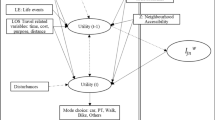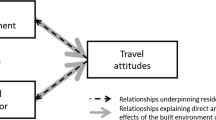Abstract
The aim of this paper is to discuss cross-lagged panel analysis in terms of the causal inferences it generates about the relationship of beliefs about modes and mode choice behavior. Frequencies of use of the single-occupant automobile (SOA), bus and carpool, as well as beliefs about each of the modes, were collected from a sample of central business district commuters at two points in time. The belief variables for each mode were summed to form composite measures and were corrected for unreliability due to measurement error.
Perceptions of each mode and the frequency of its use were analyzed for influences operating over time. A time interval was assumed to exist during which the variables causally operated on each other. It was assumed that the time necessary for an individual to change modes based on his perception was equivalent to the interval required for a person to alter perceptions based on his experience. The causal structure relating the two variables was also assumed to be stable over time. An additional assumption was required to distinguish between third variable effects, or spuriousness, and dual causation: if a third variable were to be causing the relationship, it would be operating at a relatively constant rate over time.
A strong causal relationship was found to be operating between beliefs about SOA and bus and use of those modes over time. The relationship is mutually causative; beliefs determine behavior and behavior reinforces and changes perceptions. Analysis of the carpool data indicated that the causal structure had changed over time and could not be analyzed with this technique. In general, support is evidenced for an adaptation or learning process interpretation of the relationship between beliefs and mode choice behavior.
Similar content being viewed by others
References
Beckwith, N. E. and Lehmann, D. R. (1973). “The Importance of Differential Weights in Multiple Attribute Modes of Consumer Attitude,” Journal of Marketing Research 10: 141–145.
Blalock, Hubert. (1969). “Multiple Indicators and the Causal Approach to Measurement Error,” American Journal of Sociology, 75: 264–272.
Blalock, Hubert. (1970). “Estimating Measurement Error Using Multiple Indicators and Several Points in Time,” American Sociological Review 35: 101–111.
Campbell, D. T. (1963). “From Description to Experimentation: Interpreting Trends As Quasi-Experiments,” in C. W. Harris. ed., Problems in Measuring Changes. Madison: University of Wisconsin Press.
Chaffee, S. H. (1972). “Longitudinal Designs for Communications Research: Cross-Lagged Correlation,” Presented at symposium on advanced . methodologies for communication research, August.
Churchill, Jr, G. A. (1972). “Linear Attitude Models: A Study of Predictive Ability,” Journal of Marketing Research 9, November: 243–246.
Coleman, J. S. (1968). “The Mathematical Study of Change,” in H. M. Blalock and Ann B. Blalock, Methodology in Social Research. New York: McGraw-Hill.
Dawes, R. M. and B. Corrigan. (1974). “Linear Models in Decision Making,” Psychological Bulletin 81, No. 2: 95–106.
Dobson, R. and Kehoe, J. F. (1974). “Disaggregated Behavioral Views of Transportation Attributes,” Transportation Research Record, No. 527: 1–15.
Dobson,. R., et al. (1978). “Structural Models for the Analysis of Traveler Attitude-Behavior Relationships,” presented at the Annual Transportation Research Board Meeting, Washington, D.C.
Dobson, R. and Tischer, M. L. (1978). “A Comparative Analysis of Determinants for Central Business District Worker Mode Choices,” in press, Transportation Research Record.
Duncan, O. D. (1969). “Some Linear Models for Two-Wave, Two-Variable Panel Analysis,” Psychological Bulletin 77: 177–182.
Gensch, D. and Golob, T. (1975). “Testing the Consistency of Attribute Meaning in Empirical Concept Testing,” Journal of Marketing Research 12: 348–354.
Gilbert, G. and Foerster (1974). “The Importance of Attitudes in the Decision to Use Mass Transit,” Occasional paper #7, Department of City and Regional Planning, University of North Carolina, Chapel Hill, North Carolina.
Golob, T. F., Horowitz, A. D., and Wachs, M. (1977). “Attitude-Behavior Relationships in Travel Demand Modeling,” presented at the Third International Conference on Behavioral Travel Modelling, Tonunda, South Australia.
Guilford, J. P. (1954). Psychometric Methods. New York: McGraw-Hill.
Hartgen, D. T. (1974). “Attitudinal and Situational Variables Influencing Urban Mode Choice: Some Empirical Findings,” Transportation 3:377–392.
Heise, David R. (1969). “Separating Reliability and Stability in Test-Retest Correlation,” American Sociological Review 34: 93–101.
Heise, D. R. (1970). “Causal Inference from Panel Data,” pp. 3–27 in E. F. Borgotta and G. W. Bohrnstedt eds., Sociological Methodology 1970, San Francisco: Jossey-Bass.
Hensher, D. A. (1974). “Problems of Aggregation in Disaggregate Behavioral Travel Demand Models with Emphasis on Data Requirements,” Transportation Research Board Special Report 149: 85–102.
Horowitz, A. D. (1978). “Implications of the Theories of Cognitive Dissonance and Self-Perception to the Use of Attitudes in Transportation Research and Planning,” presented at the Annual Transportation Research Board Meeting.
Horowitz, A. D., and Sheth, J. (1977). “Ridesharing to Work: A Psychosocial Analysis,” presented at the Annual Meeting of Transportation Research Board, Washington, D.C.
Howe, S. and Cohen, C. (1976). “Statewide Disaggregate Attitudinal Models for Principle Mode Choice,” presented at the Annual Transportation Research Board Meeting.
Johnson, M. A. (1975a). “Going to Work by Car, Bus, or Bart: Attitudes, Perceptions and Decisions,” working paper No. 7518, Travel Demand Forecasting Project, Institute of Transportation and Traffic Engineering, University of California, Berkeley.
Johnson, M. A. (1975b). “Psychological Variables and Choices Between Autos and Transit Travel: A Critical Research Review,” working paper No. 7509, Travel Demand Forecasting Project, University of California, Berkeley: Institute of Transportation and Traffic Engineering.
Joreskog, K. G. (1969). “A General Approach to Confirmatory Maximum Likelihood Factor Analysis,” Psychometrika 34, No. 2: 183–202.
Joreskog, K. G. (1971). “Simultaneous Factor Analysis in Several Populations,” Psychometrika 36, No. 4: 409–426.
Kenny, D. A. (1975). “Gross-lagged Panel Correlation: A Test for Spuriousness,” Psychological Bulletin 82, No. 6: 887–903.
Koppelman, F. S., Hauser, J. R., Tybout, A. M., (1978). “Analysis of Perceptions, Preferences, Beliefs, and Usage of Transportation Services for Travel to Downtown Evanston,” Consumer Oriented Transportation Service Planning, Transportation Center, Northwestern University.
Land, K. C. (1971). “Principles of Path Analyses,” pp. 3–37 in E. F. Borgatta and G. W. Bornstedt eds., Sociological Methodology 1969, San Francisco: Jossey-Bass.
Nicolaidis, C. C. (1975). “Quantification of the Comfort Variable,” Transportation Research 9: 55–66.
Pelz, D. C., and Andrews, F. M. (1964). “Detecting Causal Priorities in Panel Study Data,” American Sociological Review 29: 836–848.
Rozelle, R. M. and Campbell, D. T. (1969), “More Plausible Rival Hypotheses in the Cross-Lagged Panel Correlation Technique,” Psychological Bulletin 71: 74–80.
Spear, B. D. (1976). “A Generalized Attribute Variable for Models of Mode Choice Behavior,” Transportation Research Record, No. 592: 6–11.
Tardiff, T. J. (1977). “Causal Inferences Involving Transportation Attitudes and Behavior,” Transportation Research 11: 397–404.
Tischer, M. L., and Dobson, R. (1977). “An Empirical Analysis of Behavioral Intention to Shift Ways of Traveling to Work,” presented at Transportation Research Board Conference.
Tischer, M. L. and Shea, C. (1978), “Attitude-Behavior Change in a Before-After Mode Choice Situation,” in H. Keith Hunt, ed. Advances in Consumer Research 5, Ann Arbor: Association for Consumer Research.
Warner, H. (1976). “Estimating Coefficients in Linear Models: It Don't Make No Nevermind,” Psychological Bulletin 83, No. 2: 213–217.
Westin, R. B., and Watson, P. L. (1975). “Reported and Revealed Preferences as Determinants of Mode Choice Behavior,” Journal of Marketing Research 12: 282–289.
Author information
Authors and Affiliations
Rights and permissions
About this article
Cite this article
Tischer, M.L., Phillips, R.V. The relationship between transportation perceptions and behavior over time. Transportation 8, 21–36 (1979). https://doi.org/10.1007/BF00149849
Issue Date:
DOI: https://doi.org/10.1007/BF00149849




